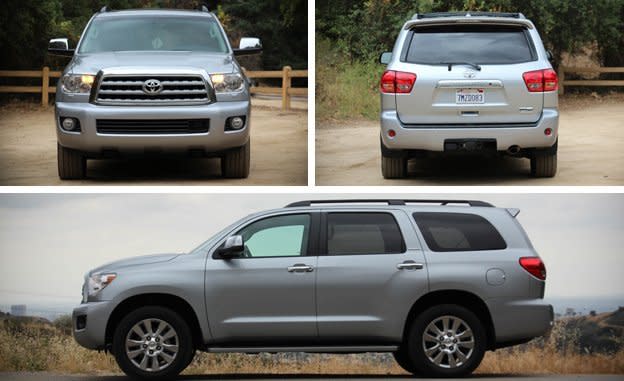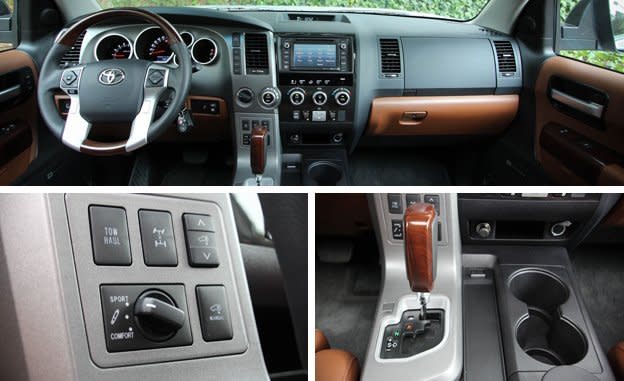2016 Toyota Sequoia

We picked up this Silver Sky metallic 2016 Toyota Sequoia Platinum on a Thursday. That’d be “Throwback Thursday” in social-media parlance, which is a fitting coincidence, in that few new vehicles are more of a throwback than this big lug. Introduced in 2008, the second-generation Sequoia has changed so little that we’re tempted to repeat, verbatim, large chunks of our 2008 Sequoia Platinum review, written in the fall of 2007. The silver 2008 and 2016 Sequoias we tested literally look identical. But while the truck hasn’t evolved, our view of it has—because the world has changed, and expectations have risen.
Same as It Ever Drove
Given that both our 2008 and 2016 test vehicles were powered by the same 381-hp 5.7-liter V-8 and tipped the scales within 12 pounds of one another, it’s no surprise that this Sequoia performed nearly exactly as it did back in ’07. Today’s Sequoia Platinum scoots to 60 mph in 6.7 seconds and covers a quarter-mile in 15.3 seconds—a negligible 0.1 second behind the 2008 model in both measures and impressive figures for a three-ton body-on-frame land yacht. The 2008 Sequoia circled our skidpad at an unsurprisingly modest 0.73 g, while we mustered only 0.71 g this year. Our new truck also required eight more feet to halt from 70 mph—192 feet versus 184 in 2008—with mild brake fade noted during testing and a spongy brake pedal diminishing the driver’s confidence in traffic. For perspective, in our 2014 comparison test, a Ford Expedition and a Chevrolet Tahoe stopped in 170 and 180 feet, respectively. The bigger Chevrolet Suburban took 190.

Out on the road, generally, the Sequoia feels big and benign. While its moves are ponderous and the structure shudders when traversing large bumps, the high seating position allows an attentive driver to get a good view of any obstacles that lie ahead. The engine is strong and rumbles in a low tenor at lower rpm, but it gets raucously thrashy as the tachometer needle approaches redline.
Inflation Sans Evolution
While the Sequoia itself hasn’t evolved, the price has. The base price on the top Platinum model has risen from $56,285 to $65,715. Eight years of simple economic inflation would make the 2008 model’s $56,285 price $62,548 in today’s dollars. Standard equipment now includes much that was formerly optional, including laser-based adaptive cruise control, a flip-down entertainment system with 9.0-inch screen for the rear seat, and a backup camera. The base SR5 model starts at $46,320 with rear-wheel drive, or nearly $20,000 less for the same gutsy motor and towing capacity of 7000-plus pounds. Now, as in 2007, we believe that the SR5 represents a stronger value. It, too, has standard navigation, second- and third-row retractable sunshades, some USB ports, a windshield-wiper de-icer, running boards, skid plates on four-by-four models, and more.
That said, some features that made the Sequoia seem compelling in 2008 now appear antiquated, particularly the fish-eye backup camera with fixed guidance lines, tunneled “Optitron” gauges, and the digital quartz clock that no Toyota of the era would be complete without. Missing altogether are modern elements that competitors all have, such as a proximity key for passive entry, LED running lamps or taillamps, and, frankly, anything particularly notable about its design. If this isn’t the most unremarkable-looking $65,000 vehicle on the market, we’re not sure what is.
There is, however, cavernous space inside for heads, shoulders, and knees, especially in the second row, which is hardly smaller than the first. The three-across, split third-row bench is also capacious and ergonomically sound, meaning knees are not thrust into one’s chin once you sit down. The huge doors, pillar-mounted grab handles, and fixed step rails make climbing in and out a cinch, and the running boards don’t extend so far out as to guarantee soiled pant legs in wet or snowy weather.

Plastic (Not) Fantastic
Unfortunately, this rolling warehouse is paneled with more Tupperware-grade plastic than you’ll find inside of a Costco. While soft-touch interiors and stitched dashboards are common in premium-grade versions of most vehicles costing half this much, the Sequoia is awash in hard plastics that border on appalling. And we find it ironic (and disappointing in equal measure) that a truck named after a tree uses such clearly fake wood trim on the steering wheel and gearshift.
Then again, the lack of precious materials may serve owners inclined to use it for its intended purposes: hauling around lots of people and things, often over long distances. The Sequoia has always been good at that, with all seats except the driver’s folding flat, a nifty second-row console that also folds, and power-folding third-row seats. Drop the second and third rows to get a whopping 120 cubic feet of space, nearly 12 more cubes than are available in the short-wheelbase Ford Expedition and an advantage of more than 25 cubic feet over the Chevrolet Tahoe and the GMC Yukon, the latter pair also hamstrung by a cargo floor that sits at an angle with the seats folded. The available cargo space in the much longer Chevrolet Suburban and GMC Yukon XL, at 121 cubic feet, barely tops the Sequoia.
Time Marches On
In 2008, the first full year this second-generation Sequoia was on the market, it commanded 9.9 percent of the full-size SUV segment. In 2015, it earned only 4.5 percent of all sales against the same nameplates. Blame the downward spiral on much fresher competition, rising consumer interest in more carlike crossovers in place of truck-based SUVs, and that Toyota appears to have utterly forsaken this vehicle—not even giving it the nicer interior and front-end treatments of the 2014–2016 Tundra pickup with which it shares mechanicals. If there’s a glimmer of good news for the Sequoia, it’s that sales are up a bit this year, with some credit certainly going to continued low gas prices and a relatively stable economy.
Unless you need every last cubic foot of space inside, it’s hard to make a compelling case to buy the Sequoia over our current favorite big utes, the aforementioned Ford Expedition and Chevrolet Tahoe/GMC Yukon twins. Shoppers who have no use for cutting-edge technology features might do well to consider the SR5, but this Platinum trim version fails to justify its lofty price.
Specifications >
VEHICLE TYPE: front-engine, 4-wheel-drive, 7-passenger, 4-door hatchback
PRICE AS TESTED: $65,715 (base price: $65,715)
ENGINE TYPE: DOHC 32-valve V-8, aluminum block and heads, port fuel injection
Displacement: 346 cu in, 5663 cc
Power: 381 hp @ 5600 rpm
Torque: 401 lb-ft @ 3600 rpm
TRANSMISSION: 6-speed automatic with manual shifting mode
DIMENSIONS:
Wheelbase: 122.0 in
Length: 205.1 in
Width: 79.9 in Height: 74.6 in
Passenger volume: 154 cu ft
Cargo volume: 19 cu ft
Curb weight: 6088 lb
C/D TEST RESULTS:
Zero to 60 mph: 6.7 sec
Zero to 100 mph: 18.2 sec
Zero to 110 mph: 23.2 sec
Rolling start, 5–60 mph: 6.9 sec
Top gear, 30–50 mph: 3.7 sec
Top gear, 50–70 mph: 4.5 sec
Standing ¼-mile: 15.3 sec @ 93 mph
Top speed (governor limited): 115 mph
Braking, 70–0 mph: 192 ft
Roadholding, 300-ft-dia skidpad: 0.71 g
FUEL ECONOMY:
EPA city/highway driving: 13/17 mpg
C/D observed: 13 mpg

 Yahoo Autos
Yahoo Autos 